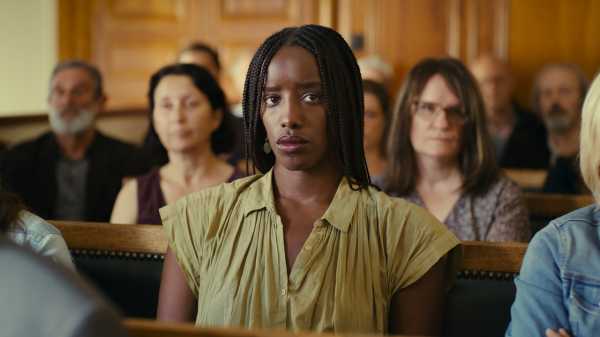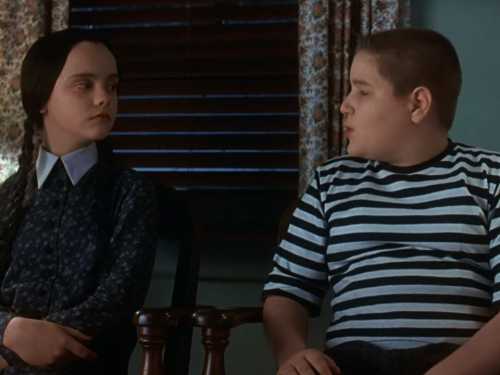
On a long and deep beach at night, with little but moonlight shimmering vaguely on the waves, a woman gently but unhesitatingly deposits a baby in the sand, near the rising tide, and walks away. I’d have sworn that I saw this in the French director Alice Diop’s film “Saint Omer,” yet I’d also swear that I didn’t—because, although no such scene is included in the movie, it’s described so vividly in the course of the action that I felt as if it was shown onscreen. The person who describes the event is Laurence Coly (played by Guslagie Malanda), who is accused of killing her baby in this manner, and whose detailed confession of her crime occurs in the courtroom, in the course of her trial. Diop does more in “Saint Omer” than create an original and far-reaching courtroom drama; she establishes an aesthetic, distinctive to the courtroom setting, that seemingly puts the characters’ language itself in the frame along with the psychological vectors that connect them. This spare and straightforward method gives rise to a film of vast reach and great complexity.
“Saint Omer,” which goes into wide release Friday, is both a docudrama and an implicit metafiction, placing the filmmaker’s surrogate in the onscreen action. The movie’s protagonist isn’t Laurence but, rather, a thirtysomething writer and professor named Rama (Kayije Kagame), who attends the trial in order to write a book about Laurence, and whose point of view as an observer is the one through which the details of the trial are conveyed. Diop based the movie on the real-life case of Fabienne Kabou, who was tried, in 2016, in the northern French town of the title, for killing her own baby—and Diop in fact attended that trial.
The film’s two main characters, and their real-life cognates, are Black women. Like Rama, Diop was born in France to a Senegalese family; like Laurence, Kabou was born and raised in Senegal and came to France to attend university. On the basis of the narrow premise of this trial, Diop creates a wide-ranging and probing drama, along with something of a meta-drama, to explore such critical matters as the nature of personal and national identity, the multigenerational traumas of migration, France’s ongoing political and cultural failures to reflect its ethnic and racial diversity, and, centrally, the very power of language to create images and to embody realities. What’s more, that power, which is the engine of Diop’s mightily inventive cinematic craft, turns out to be a dangerous one, setting Rama’s (and, implicitly, Diop’s) creative drive, her artistic sensibility, into conflict with her sense of justice and, for that matter, with her sense of self.
Diop starts the film with a shot of a Black woman carrying a baby, in what appears to be a nightmare from which Rama awakens, calling for her mother. She’s comforted by her partner, a white man named Adrien (Thomas de Pourquery), a musician. A series of calmly observed sequences—Rama, in a lecture hall, teaching a class centered on Marguerite Duras’s use of language to transform a woman’s public degradation into exaltation; Rama, with Adrien and her siblings, at the apartment of her elderly mother (Adama Diallo Tamba); Rama’s childhood memory of her mother’s remote sternness—sketches Rama’s self-image with a thematically focussed clarity that, at the trial, snaps into connection with the defendant in ways that both fuel Rama’s drive to depict Laurence artistically and yet also disturb and even frighten the writer.
Diop’s distinctive dramatization of the trial—and its impact on Rama—arises from France’s specific judicial practices, in which defendants are subject to direct questioning by judges as well as by prosecutors and defense attorneys. In composing the courtroom scenes, Diop (who wrote the script with Amrita David and Marie NDiaye) gives the characters, and especially Laurence, virtual arias: extended scenes and lengthy monologues in which they develop the narratives that their interrogators demand of them. When questioning Laurence, the presiding judge (played by Valérie Dréville) starts by examining the defendant’s entire life story—birth and childhood, family and friends, interests and ambitions and inclinations, the ins and outs of her years in France—before getting started on the details of the crime itself, and the judge doesn’t hesitate to interrupt in order to challenge Laurence with information that she has got from other witnesses.
The account that Laurence gives of herself is a strange one. Though she admits to having killed her daughter, Elise, she pleads not guilty and declares herself not to be responsible for her actions. She claims to be the target of sorcery, both from her family in Senegal and from her former partner, the father of her child, Luc Dumontet (Xavier Maly), a white man more than thirty years her senior—though, when asked by the judge why she did it, she answers that she herself hopes to learn why by means of the trial itself. There’s something peculiar about the oblivious cultural assumptions on which the trial runs. The three judges, the defense attorney, and the prosecutor are white; there isn’t a Black juror in view. (For that matter, when Rama walks through the small town, there’s hardly a Black person in sight.) As a result, the judge’s incredulity about Laurence’s claims of hallucinations and curses goes unchallenged, as does, say, the skepticism of one of Laurence’s professors (Charlotte Clamens) regarding the sincerity of her interest in Wittgenstein rather than “someone closer to her own culture.” Rama, too, confronts similar blind spots in her own field. When she speaks by phone with her editor (voiced by Alain Payen) about the plan to write a book about Laurence—she wants to title it “Medea Castaway”—he notes that Laurence is said to speak “very sophisticated French.” (It comes off as if he’d called her “articulate.”) Rama retorts that the defendant merely “talks like an educated woman.”
Laurence’s testimony reveals her embittered relationship with Luc, a former businessman and a sculptor, who is married to another woman, from whom he’s separated. (Even her pregnancy and the child’s birth, as retold one way by Laurence and another way by the stuffy and tremulous Luc, is a mighty melodrama of secrets and lies.) An encounter with Laurence’s mother (Salimata Kamate) gives Rama a glimpse at the deforming force of their conflict-ridden bond. In the course of the trial, Rama finds herself drawn into a closer, more empathetic connection with Laurence, across the distance of the courtroom, by dint of their similar experiences and backgrounds—their implicit solidarity as Black women (the only two in the courtroom, other than Laurence’s mother), which is emphasized when Laurence turns her head and, with a smile, catches Rama’s eye.
That exchange of glances is the fulcrum of “Saint Omer” and one of the most striking moments in any recent film. Its enormous dramatic power is the product of Diop’s ingenious visual schema, one that’s all the more striking for its simplicity. (Kudos to the cinematographer Claire Mathon for her precise and lucid realization of it.) The physical organization of the Saint Omer courtroom is a virtual character in the movie: Laurence is seated in a witness box of her own, against a wall, at a ninety-degree angle from the judges’ and spectators’ points of view. (Other witnesses testify from a small lectern near the center of the room; they and Laurence are all required to testify standing up.) When Laurence first speaks, she’s depicted from the visual point of view of Rama, who’s seated with a few dozen other spectators at the rear of the courtroom. Thereafter, Diop shows Laurence from a different angle and distance for each extended sequence of Laurence’s testimony, and these angles are, for the most part, head-on, a detached visual point of view that’s associated with no specific character in the courtroom. Nonetheless, these frontal views of Laurence come off as being identified with Rama—not visually but intellectually, abstractly. It’s as if the viewer were seeing Laurence not through Rama’s eyes but through her mind’s eye, as if the discerning analyses and transformative rhetoric of Rama’s writing mind were being embodied in real time by way of Diop’s images.
That’s why the switch to a moment of actual visual connection, when Rama and Laurence lock eyes in the courtroom, comes as such a shock—and why it embodies a dramatic moment of crisis. In that instant, Rama recognizes that she’s being pulled into complicity with Laurence in a way that induces her to overlook Laurence’s heinous deed, that gets her to neglect (as she tells Adrien) the life of the child that has been lost, and which even risks luring her into Laurence’s defense—in effect, helping Laurence get away with murder. That moment decisively throws the moral onus of the film onto Rama and converts the drama to one of her own consciousness. Spoiler alert: Rama is pregnant, and, in the overlap of her background and experience with those of Laurence, she envisions her own maternity as a potential crisis and horror. Laurence’s narration has a persuasive authority that does more than create images; by way of the cultural bonds connecting her to Rama, it creates, in effect, self-images for Rama, ones that she finds herself vehemently resisting.
Diop never shows the verdict; the movie abandons the courtroom before it’s rendered. (In real life, Kabou was sentenced to twenty years’ imprisonment but also given psychological treatment.) In this regard, “Saint Omer” brings to mind a similar scene in another recent film, “Till.” There, when Emmett Till’s mother, Mamie Till-Mobley (Danielle Deadwyler), attends the trial—in a Mississippi court, with a white judge and an all-white jury—of two white men accused of killing Emmett, she leaves before the verdict is rendered, saying, “I know what the verdict is.” In “Saint Omer,” Diop, by eliding the verdict and taking the film out of the courtroom before it’s rendered, again incarnates Rama’s internal perspective. Diop doesn’t suggest that the white-dominated court will inevitably issue an unjust verdict in the case of a Black woman, but that this court is the wrong place to tell the story of her crime and all its implications. Rather, this movie, with all the personal and moral risk to the artist that it entails, is the right one. ♦
Sourse: newyorker.com






